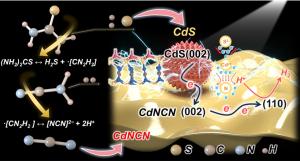GA, UNITED STATES, November 7, 2024 /EINPresswire.com/ -- This study presents a novel approach utilizing the concentration gradient of thiourea dissociation products to synthesize a CdNCN-CdS composite photocatalyst with an atomic-level heterostructure (NCN-Cd-S). The strong electron affinity of CdNCN and efficient electron transfer at the interface enhance photocatalytic hydrogen evolution, achieving a record-high rate of 14.7 mmol·g⁻¹·h⁻¹ under visible light, surpassing other CdS-based composites.
Solar-driven photocatalytic water splitting offers a sustainable route for hydrogen production. Researchers have explored various semiconductors, but challenges like bandgap limitations and carrier recombination persist.
CdNCN, a transition metal carbodiimide, shows promise with its favorable band gap and strong covalent bonding. Combining CdNCN with CdS heterostructures improves electron transport and separation through quasi-crystalline transition sites. However, the down side is that traditional CdNCN synthesis requires toxic reagents, posing scalability issues.
In a study (doi: https://doi.org/10.1016/j.apmate.2024.100242) published in the KeAi journal Advanced Powder Materials, a team of researchers from China and Australia presents a novel approach for synthesizing CdNCN-CdS heterostructures under mild conditions, offering advancements in solar-driven photocatalysis for hydrogen production.
A key finding is the "one-pot" synthesis method utilizing thiourea, which simplifies the process by forming [NCN]²⁻ moieties during decomposition. "By leveraging the electron-attracting characteristics of the carbodiimide group in CdNCN, we established a rapid electron transfer pathway, resulting in record-breaking hydrogen evolution efficiency without additional cocatalysts," shares the study's senior and co-corresponding author Shengsen Zhang.
Notably, the optimized CdNCN-CdS heterostructure demonstrated a hydrogen evolution rate of 14.7 mmol g⁻¹ h⁻¹ under visible light irradiation—surpassing previously reported CdS-based catalysts. "This exceptional performance stems from the creation of atomic-level N–Cd–S transition sites, which minimize electron transfer resistance and direct electrons to the CdNCN (110) plane, the optimal site for hydrogen adsorption," says Zhang.
An exciting aspect of the research is the control over catalyst composition by adjusting the Cd-to-thiourea ratio. Through in-situ spectroscopy techniques, the researchers confirmed that intermediate [NCN]²⁻ moieties bind tightly with Cd atoms, enhancing charge transport within the heterostructure.
"The findings highlight the importance of using a green and scalable synthesis approach to overcome the challenges of semiconductor-based photocatalysis — a step toward sustainable hydrogen production."
DOI
10.1016/j.apmate.2024.100242
Original Source URL
https://doi.org/10.1016/j.apmate.2024.100242
Funding information
This work is supported by the National Natural Science Foundation of China (Nos. 22078118, 22274059 and 42277219) and the Natural Science Foundation of Guangdong Province, China (Nos. 2023A1515010740 and 2023A1515030131).
Lucy Wang
BioDesign Research
email us here
Legal Disclaimer:
EIN Presswire provides this news content "as is" without warranty of any kind. We do not accept any responsibility or liability for the accuracy, content, images, videos, licenses, completeness, legality, or reliability of the information contained in this article. If you have any complaints or copyright issues related to this article, kindly contact the author above.
© 2024 Benzinga.com. Benzinga does not provide investment advice. All rights reserved.
Comments
Trade confidently with insights and alerts from analyst ratings, free reports and breaking news that affects the stocks you care about.
